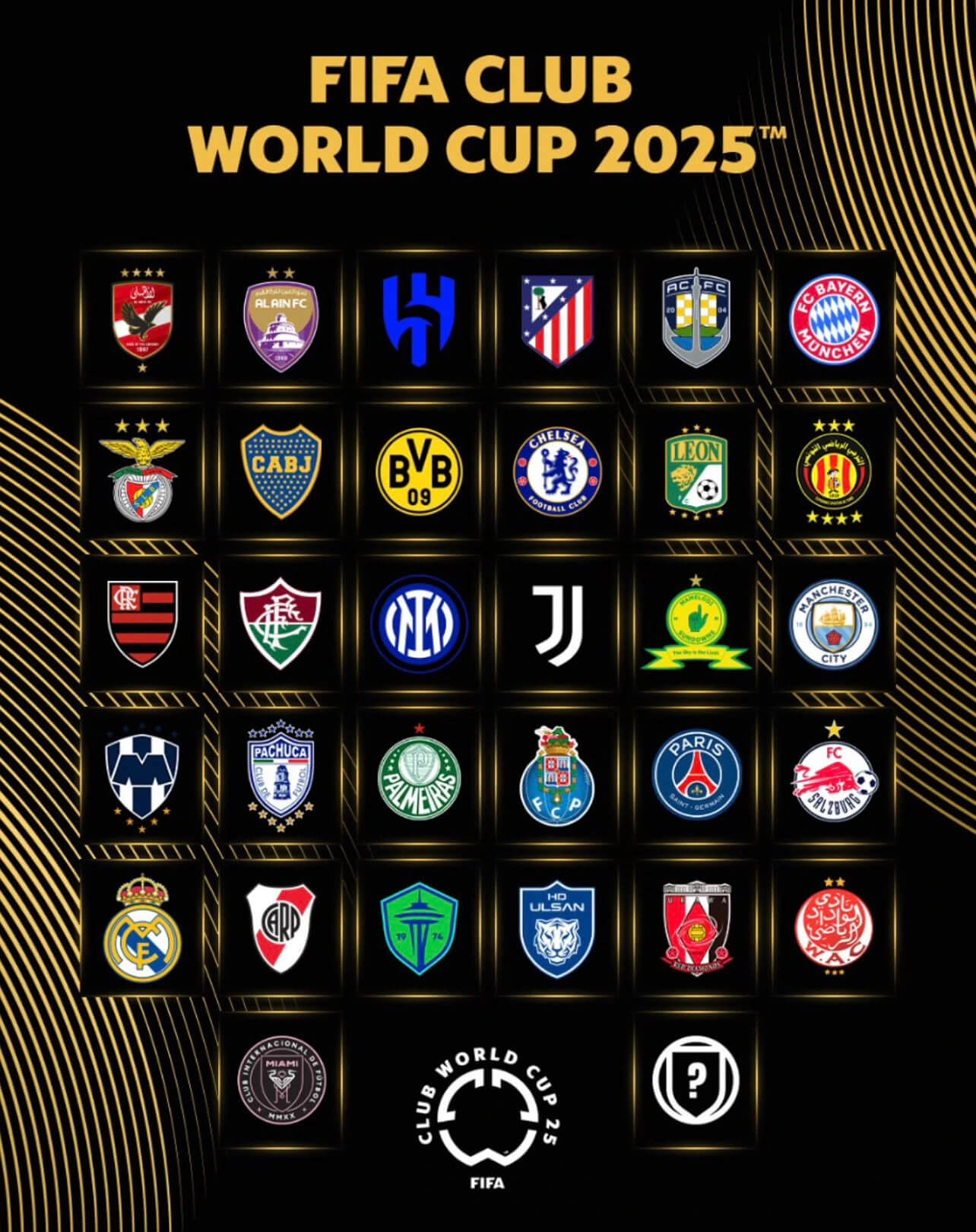FIFA 2025 Club World Cup Teams: Complete List of All 32 Qualified Clubs


The FIFA 2025 Club World Cup represents a revolutionary transformation in global club football, expanding from its traditional format to include 32 elite teams from around the world. Set to take place in the United States from June 14 to July 13, 2025, this tournament marks the beginning of a new era where the world's most prestigious clubs will compete in a month-long spectacular event that mirrors the FIFA World Cup format.
Revolutionary Tournament Format and Structure
We are witnessing the most significant evolution in club football competition history. The 2025 FIFA Club World Cup adopts an expanded format featuring 32 teams divided into eight groups of four teams each. This structure follows the same successful model used in FIFA World Cups between 1998 and 2022, with the top two teams from each group advancing to the knockout stage.
The tournament will utilize a single-elimination knockout format following the group stage, culminating in a final that will determine the world's premier club team. Unlike previous iterations, this expanded format eliminates the need for a third-place playoff, focusing entirely on crowning the ultimate champion.

Confederation Slot Allocation System
The qualification system for the FIFA 2025 Club World Cup is based on a carefully calculated distribution of slots among the six FIFA confederations. This allocation reflects both historical performance and competitive balance across global football:
Regional Slot Distribution Table
Confederation | Region | Allocated Slots | Percentage |
|---|---|---|---|
UEFA | Europe | 12 | 37.5% |
CONMEBOL | South America | 6 | 18.75% |
AFC | Asia | 4 | 12.5% |
CAF | Africa | 4 | 12.5% |
CONCACAF | North/Central America | 4 | 12.5% |
OFC | Oceania | 1 | 3.125% |
Host Nation | United States | 1 | 3.125% |
Total | Global | 32 | 100% |
Complete List of All 32 Qualified Teams by Region
UEFA European Teams (12 Teams)
Team | Country | City | Featured Players | Global Ranking |
|---|---|---|---|---|
Real Madrid | Spain | Madrid | Mbappé, Bellingham, Vinicius Jr., Rodrygo | 1 |
Manchester City | England | Manchester | Haaland, De Bruyne, Rodri, Foden | 2 |
Chelsea | England | London | Palmer, Enzo Fernández, Jackson, Caicedo | 4 |
Bayern Munich | Germany | Munich | Kane, Musiala, Davies, Kimmich | 3 |
Paris Saint-Germain | France | Paris | Dembélé, Vitinha, Hakimi, Marquinhos | 5 |
Inter Milan | Italy | Milan | Lautaro, Barella, Bastoni, Thuram | 8 |
Porto | Portugal | Porto | Pepe, Otavio, Taremi, Eustaquio | 12 |
Benfica | Portugal | Lisbon | Di María, João Neves, Aktürkoglu, Bah | 15 |
Borussia Dortmund | Germany | Dortmund | Adeyemi, Brandt, Schlotterbeck, Füllkrug | 11 |
Juventus | Italy | Turin | Vlahović, Chiesa, McKennie, Locatelli | 9 |
Atlético Madrid | Spain | Madrid | Griezmann, Koke, Giménez, Morata | 10 |
Red Bull Salzburg | Austria | Salzburg | Šeško, Kjærgaard, Capaldo, Dedić | 18 |
CONMEBOL South American Teams (6 Teams)
Team | Country | City | Featured Players | Global Ranking |
|---|---|---|---|---|
Palmeiras | Brazil | São Paulo | Endrick, Raphael Veiga, Weverton, Piquerez | 6 |
Flamengo | Brazil | Rio de Janeiro | Gabigol, Bruno Henrique, De la Cruz, Arrascaeta | 7 |
Fluminense | Brazil | Rio de Janeiro | Germán Cano, André, Nino, Martinelli | 14 |
River Plate | Argentina | Buenos Aires | Borja, Kranevitter, Armani, Simón | 13 |
Boca Juniors | Argentina | Buenos Aires | Cavani, Merentiel, Romero, Advíncula | 16 |
Botafogo | Brazil | Rio de Janeiro | Tiquinho Soares, Almada, John, Marlon Freitas | 17 |
AFC Asian Teams (4 Teams)
Team | Country | City | Featured Players | Global Ranking |
|---|---|---|---|---|
Al-Hilal | Saudi Arabia | Riyadh | Neymar, Mitrović, Kanno, Malcolm | 19 |
Urawa Red Diamonds | Japan | Saitama | Sekine, Sakai, Nishi, Koizumi | 22 |
Al-Ain | UAE | Al Ain | Soufiane Rahimi, Bandar Al Ahbabi, Park Yong-woo | 24 |
Ulsan HD | South Korea | Ulsan | Joo Min-kyu, Lee Gyu-sung, Hong Myung-bo | 26 |
CAF African Teams (4 Teams)
Team | Country | City | Featured Players | Global Ranking |
|---|---|---|---|---|
Al Ahly | Egypt | Cairo | Percy Tau, Mohamed Hany, Aliou Dieng | 20 |
Wydad AC | Morocco | Casablanca | Ayoub El Amloud, Yahya Attiat Allah, Bouly Sambou | 23 |
Esperance | Tunisia | Tunis | Yassine Meriah, Mohamed Ali Ben Romdhane, Raed Bouchniba | 25 |
Mamelodi Sundowns | South Africa | Pretoria | Peter Shalulile, Themba Zwane, Ronwen Williams | 27 |
CONCACAF North/Central American Teams (4 Teams)
Team | Country | City | Featured Players | Global Ranking |
|---|---|---|---|---|
Monterrey | Mexico | Monterrey | Rogelio Funes Mori, Sergio Canales, Rodolfo Pizarro | 21 |
Seattle Sounders FC | USA | Seattle | Raúl Ruidíaz, Jordan Morris, João Paulo, Stefan Cleveland | 28 |
Los Angeles FC | USA | Los Angeles | Carlos Vela, Giorgio Chiellini, Gareth Bale, Kellyn Acosta | 29 |
Club León | Mexico | León | Lucas Romero, Ángel Mena, José Alvarado, Federico Viñas | 30 |
OFC Oceania Team (1 Team)
Team | Country | City | Featured Players | Global Ranking |
|---|---|---|---|---|
Auckland City FC | New Zealand | Auckland | Myer Bevan, Adam Mitchell, Cameron Brown, Gerard Garriga | 31 |
Host Nation Team (1 Team)
Team | Country | City | Featured Players | Global Ranking |
|---|---|---|---|---|
Inter Miami CF | USA | Miami | Lionel Messi, Luis Suárez, Jordi Alba, Sergio Busquets | 32 |
UEFA European Powerhouses Leading the Pack
European clubs dominate the FIFA 2025 Club World Cup with 12 qualifying positions, reflecting the continent's exceptional competitive strength in recent years. The UEFA qualification system is based on performances in the UEFA Champions League over the past four seasons, ensuring that only the most consistently successful clubs earn their place.
Notable UEFA Qualifiers
Real Madrid leads the European contingent as the most successful club in recent Champions League history. Their qualification represents not just their domestic success but their unparalleled international dominance. Manchester City, the current Premier League champions and previous Club World Cup winners, brings their tactical sophistication and depth to the tournament.
Chelsea, despite recent challenges, secured their qualification through their strong Champions League performances over the qualifying period. The London club's experience in high-pressure knockout competitions makes them a formidable opponent for any team in the tournament.
Other European giants include clubs from Germany's Bundesliga, Spain's La Liga, Italy's Serie A, and France's Ligue 1, creating an unprecedented representation of European football excellence.
CONMEBOL South American Excellence
South American football commands significant respect with six allocated slots in the FIFA 2025 Club World Cup. The CONMEBOL qualification system mirrors UEFA's approach, focusing on Copa Libertadores performances over the past four seasons.
The intensity and passion characteristic of South American football will be on full display, with clubs bringing their unique tactical approaches and technical brilliance to the global stage. These teams traditionally perform exceptionally well in Club World Cup competitions, often challenging European dominance with their distinctive playing styles.
Asian, African, and CONCACAF Representatives
AFC Asian Contingent
The Asian Football Confederation contributes four teams to the tournament, with Al-Hilal from Saudi Arabia being among the most notable qualifiers. Asian clubs have invested heavily in international talent and infrastructure, making them increasingly competitive on the global stage.
CAF African Champions
African clubs also secure four slots, representing the continent's growing football influence. These teams bring athletic prowess, technical skill, and tactical innovation that consistently surprises opponents from other confederations.
CONCACAF North American Presence
The CONCACAF region provides four qualifying teams, including notable clubs like Monterrey from Mexico and Seattle Sounders FC from Major League Soccer. The Seattle Sounders qualified through their historic 2022 CONCACAF Champions Cup victory, demonstrating MLS's rising competitive level.
Los Angeles FC secured their position as a replacement after León was disqualified by FIFA, showcasing the depth of talent in North American football.
Host Nation Special Allocation
Inter Miami CF represents the host nation allocation, having earned their place through winning the 2024 MLS Supporters' Shield. This appointment brings additional excitement to American football fans and demonstrates FIFA's commitment to developing football in the United States ahead of the 2026 FIFA World Cup.
Global Rankings and Competitive Analysis
Detailed Team Analysis by Confederation
UEFA European Powerhouses Analysis
European teams bring the highest level of tactical sophistication and financial investment to the tournament. Real Madrid, Chelsea, and Manchester City are among the notable European qualifiers, each representing different tactical philosophies and playing styles.
Real Madrid's squad features the perfect blend of experience and youth, with Kylian Mbappé leading their attack alongside Jude Bellingham and Vinicius Jr. Their European dominance in recent years makes them the tournament favorites.
Manchester City under Pep Guardiola brings their possession-based philosophy, with Erling Haaland's goal-scoring prowess and Kevin De Bruyne's creative genius forming the backbone of their system.
CONMEBOL Technical Excellence
South American clubs traditionally excel in Club World Cup competitions due to their technical brilliance and tactical flexibility. Palmeiras leads the Brazilian contingent with their balanced squad featuring Endrick and Raphael Veiga.
Flamengo brings star power with Gabigol and Bruno Henrique, while River Plate and Boca Juniors represent Argentine football's rich tradition and passionate fanbase.
AFC Asian Rising Powers
Al-Hilal stands out as the premier Asian representative, featuring global superstars like Neymar and Aleksandar Mitrović. Their significant investment in international talent demonstrates the growing ambition of Middle Eastern football.
Urawa Red Diamonds from Japan bring their technical precision and disciplined approach, while Ulsan HD represents South Korean football's tactical evolution.
Regional Tactical Diversity Table
Region | Tactical Style | Key Strengths | Notable Feature |
|---|---|---|---|
Europe | Possession-based, Tactical | Technical skill, Financial power | Advanced analytics |
South America | Technical, Creative | Individual brilliance, Passion | Youth development |
Asia | Disciplined, Athletic | Physical preparation, Organization | Investment growth |
Africa | Athletic, Dynamic | Pace, Power, Determination | Emerging talent |
North America | Physical, Direct | Set pieces, Counter-attacks | League development |
Oceania | Community-based | Team spirit, Local pride | Grassroots focus |
Teams Performance Rankings and Statistics
Global Club Rankings Based on Recent Performance
Global Rank | Team | Confederation | Recent Titles | UCL/Continental Success | Market Value (€M) |
|---|---|---|---|---|---|
1 | Real Madrid | UEFA | La Liga 2024, UCL 2024 | 15 UCL titles | 1,200 |
2 | Manchester City | UEFA | Premier League 2024 | UCL 2023 | 1,100 |
3 | Bayern Munich | UEFA | Bundesliga 2024 | 6 UCL titles | 950 |
4 | Chelsea | UEFA | Conference League 2024 | 2 UCL titles | 850 |
5 | PSG | UEFA | Ligue 1 2024 | 0 UCL titles | 800 |
6 | Palmeiras | CONMEBOL | Copa Libertadores 2021 | 3 Libertadores | 180 |
7 | Flamengo | CONMEBOL | Copa Libertadores 2022 | 3 Libertadores | 170 |
8 | Inter Milan | UEFA | Serie A 2024 | 3 UCL titles | 750 |
Tournament Favorites Analysis
Tier | Teams | Championship Probability | Key Strengths |
|---|---|---|---|
Tier 1 | Real Madrid, Man City, Bayern | 60% | Experience, Star power, Depth |
Tier 2 | Chelsea, PSG, Inter Milan | 25% | Tactical flexibility, Quality |
Tier 3 | Palmeiras, Flamengo, Al-Hilal | 12% | Regional dominance, Passion |
Tier 4 | Remaining teams | 3% | Dark horse potential |
Head-to-Head Historical Performance
Region Matchup | Historical Success Rate | Notable Victories | Playing Style Advantage |
|---|---|---|---|
Europe vs South America | Europe 65% | Real Madrid dominance | Tactical discipline |
Europe vs Asia | Europe 85% | Consistent superiority | Financial resources |
South America vs Asia | South America 70% | Technical superiority | Individual brilliance |
Europe vs Africa | Europe 80% | Infrastructure advantage | Professional development |
Star Players Analysis by Position
World-Class Forwards and Attackers
Player | Team | Position | Nationality | Key Attributes |
|---|---|---|---|---|
Kylian Mbappé | Real Madrid | Forward | France | Speed, Finishing, Dribbling |
Erling Haaland | Manchester City | Striker | Norway | Clinical finishing, Physical presence |
Lionel Messi | Inter Miami | Forward | Argentina | Playmaking, Free kicks, Experience |
Neymar | Al-Hilal | Winger | Brazil | Creativity, Skills, Set pieces |
Harry Kane | Bayern Munich | Striker | England | Clinical finishing, Leadership |
Endrick | Palmeiras | Forward | Brazil | Pace, Youth potential, Finishing |
Gabigol | Flamengo | Striker | Brazil | Goal scoring, Big game experience |
Elite Midfield Maestros
Player | Team | Position | Nationality | Key Attributes |
|---|---|---|---|---|
Jude Bellingham | Real Madrid | Midfielder | England | Box-to-box, Versatility, Leadership |
Kevin De Bruyne | Manchester City | Midfielder | Belgium | Passing, Vision, Long shots |
Sergio Busquets | Inter Miami | Midfielder | Spain | Defensive midfielder, Experience |
Cole Palmer | Chelsea | Attacking Mid | England | Creativity, Set pieces, Goals |
Enzo Fernández | Chelsea | Midfielder | Argentina | Passing, Work rate, Versatility |
Raphael Veiga | Palmeiras | Midfielder | Brazil | Set pieces, Leadership, Goals |
Defensive Stalwarts and Goalkeepers
Player | Team | Position | Nationality | Key Attributes |
|---|---|---|---|---|
Virgil van Dijk | Liverpool | Defender | Netherlands | Aerial ability, Leadership, Pace |
Jordi Alba | Inter Miami | Left-back | Spain | Attacking threat, Experience, Crossing |
Giorgio Chiellini | Los Angeles FC | Defender | Italy | Experience, Positioning, Leadership |
Weverton | Palmeiras | Goalkeeper | Brazil | Shot stopping, Distribution, Leadership |
Stefan Cleveland | Seattle Sounders | Goalkeeper | USA | Reflexes, Distribution, Consistency |
Tactical Innovations and Playing Styles
Teams qualified for the 2025 Club World Cup represent diverse tactical philosophies and playing styles. European clubs typically emphasize tactical sophistication and systematic approaches, while South American teams focus on technical brilliance and creative expression.
Asian and African representatives bring athleticism and unique tactical innovations that often catch opponents off-guard. This diversity creates fascinating tactical matchups and ensures that the tournament showcases football's global evolution.
Tournament Significance and Global Impact
The expanded FIFA Club World Cup format represents FIFA's vision for elevating club football to unprecedented heights. By bringing together 32 of the world's finest clubs, the tournament creates opportunities for cultural exchange, tactical innovation, and sporting excellence that transcends traditional boundaries.
Commercial and broadcasting implications are substantial, with the tournament expected to reach global audiences exceeding 500 million viewers. This exposure benefits not only participating clubs but also the broader development of football in emerging markets.
Preparation and Expectations
Clubs have been preparing intensively for this historic tournament, adjusting their pre-season schedules and transfer strategies to ensure peak performance during the competition. The prize money and prestige associated with the Club World Cup title motivate teams to prioritize this competition alongside their domestic league campaigns.
Fan engagement reaches new levels as supporters from different continents converge in the United States, creating an atmosphere comparable to the FIFA World Cup. This cultural exchange enhances football's role as a global unifying force.
Future Implications for Club Football
The 2025 FIFA Club World Cup establishes a precedent for future tournaments, potentially leading to regular expanded Club World Cup competitions. This evolution could fundamentally alter the football calendar and create new revenue streams for participating clubs.
Youth development programs and coaching exchanges facilitated by this tournament contribute to football's global development. Clubs use this platform to showcase their academies and playing philosophies to international audiences.
The tournament's success will likely influence FIFA's future decisions regarding international club competitions, potentially leading to more frequent expanded tournaments and greater integration between continental confederations.
Conclusion: The FIFA 2025 Club World Cup represents the pinnacle of club football competition, bringing together the world's elite teams in an unprecedented showcase of tactical excellence, athletic prowess, and global sporting culture. With 32 qualified teams representing every continent, this tournament promises to deliver unforgettable moments and crown a truly deserving world champion.
FIFA 2025 Club World Cup: The Guide to the Tournament
FIFA 2025 Club World Cup: Complete Match Schedule and Tournament Fixtures
FIFA 2025 Club World Cup Betting Guide - Mathematical Models
FIFA Club World Cup 2025: Top Contenders for Best Player Award
FIFA Club World Cup 2025 Live Stream: Complete Global Broadcasting Guide
Bonus up






Sign up for our newsletter to receive expert sports betting tips and exclusive offers.